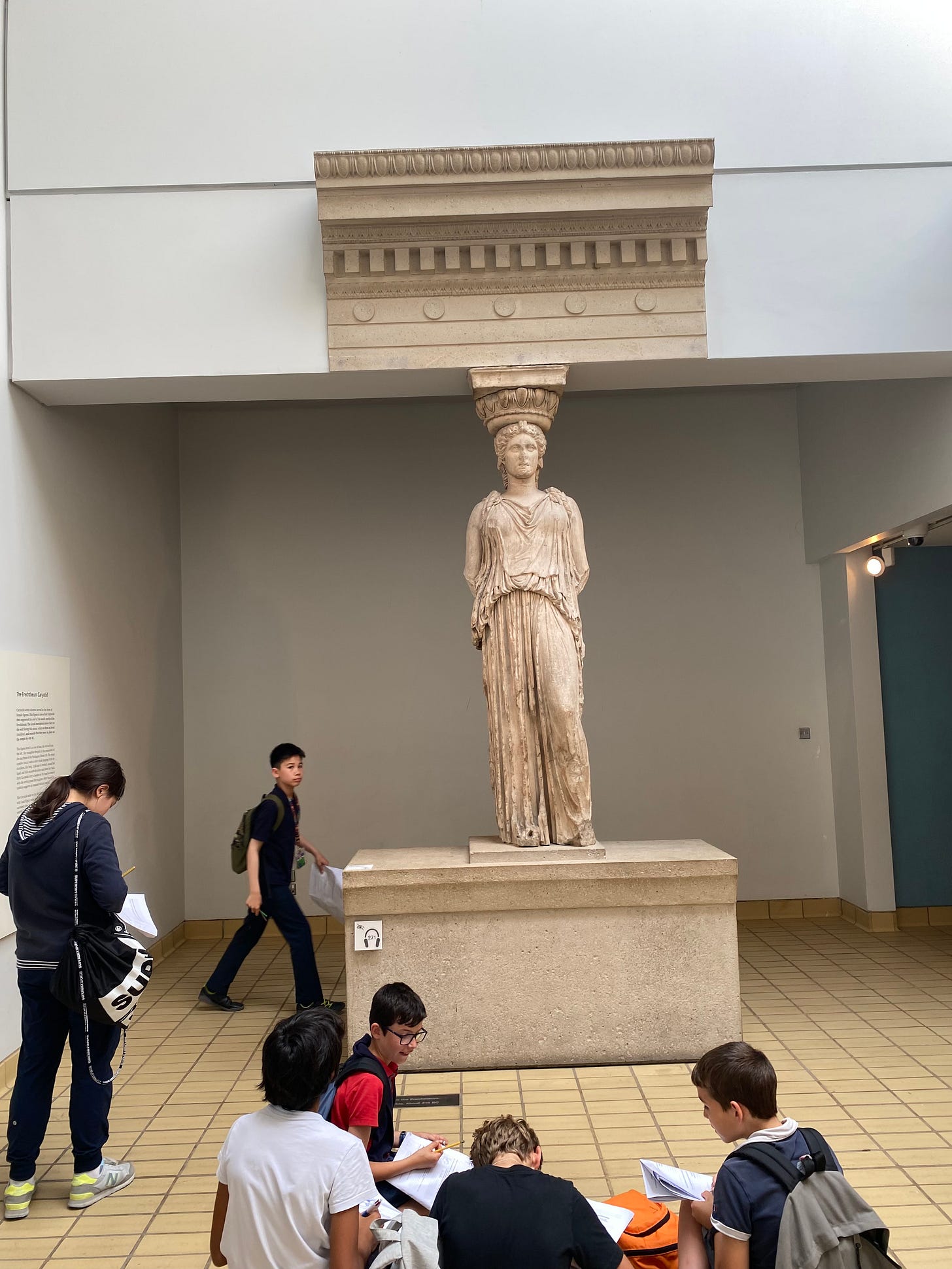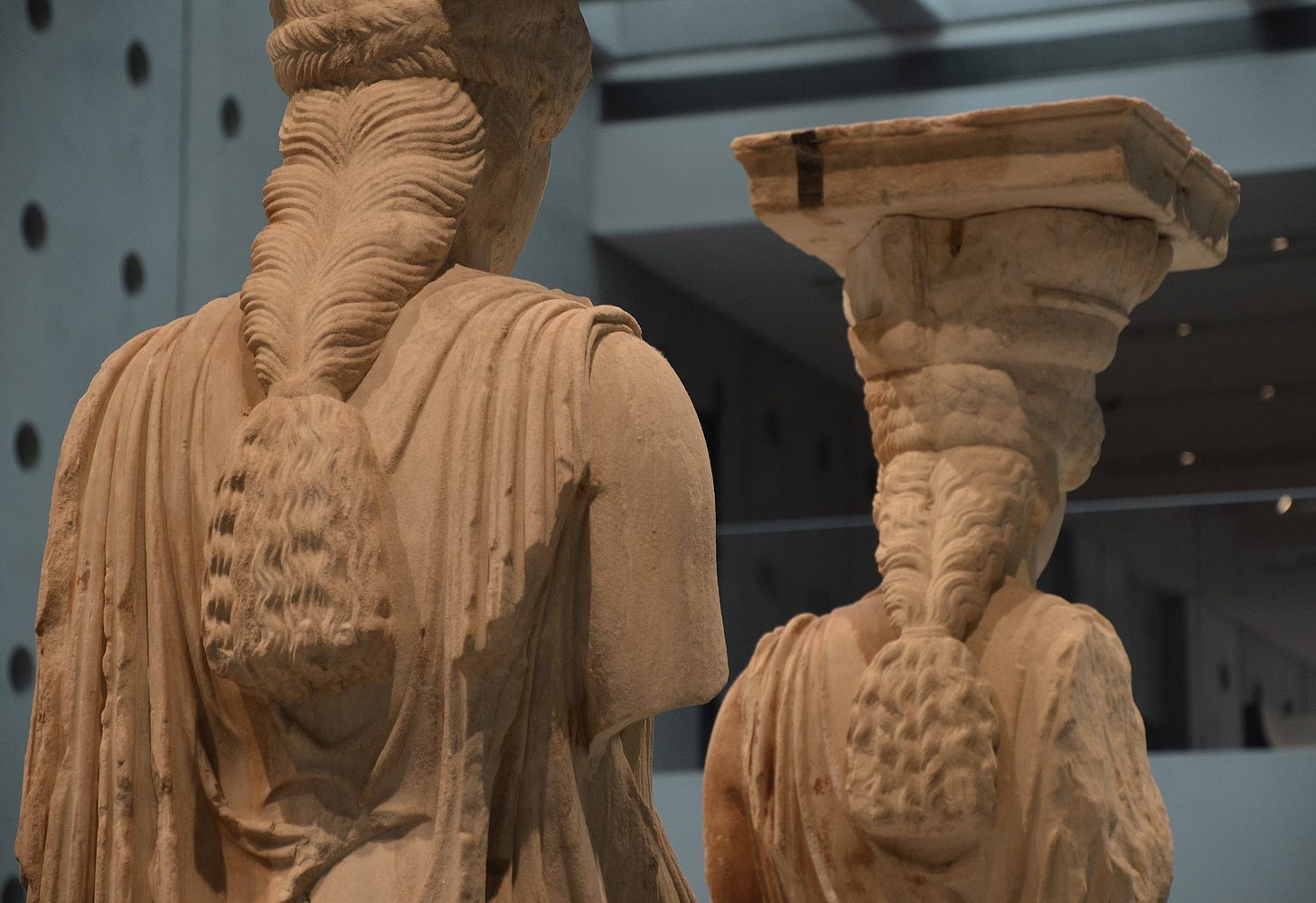I wasn’t expecting a Caryatid to tip me over the edge, but that’s exactly what happened.
We were at the British Museum in London just last week, on a quick stopover before heading to the Lake District for the visit of a lifetime.
It was sort of silly to try to squeeze the Museum in amidst a very busy travel day, but I’d never been, and there it was, a twenty-minute walk from St. Pancras Station where our Eurostar train from Paris terminated.
So we went.
It was a hot day in London, crowded with tourists, and I was already emotionally exhausted. There was way too much to look at. Just the Mycenaean Bronze Age stuff was mind-blowing, let alone everything else.
Deep breath.
What’s more, the Museum was a sauna: guards were camped out next to small fans that were doing nothing for the temperature and humidity.
Wipe brow. Hitch up daypack on sweaty shoulder.
So when I saw the solitary Caryatid there among the Acropolis pieces taken to London by Lord Elgin in 1805, I lost it.

I’ve never wept in front of a statue before. I felt very silly.
But it made perfect sense.
The Caryatids (also known as the Erechtheion maidens) are ultra-famous statues of young women that were used as pillars for an ultra-famous temple on the Acropolis, dedicated to Athena, Poseidon, and Erechtheus, the founding hero of Athens. They are not goddesses and do not take part in Greek mythology, but scholars still don’t know exactly who they were supposed to represent.
So the statue of the young woman with the odd-looking capital on her head didn’t resonate with me because of a story or a religious belief.
It was something that happened earlier this summer.
On my recent school trip to Greece, our guide in the Acropolis Museum (as always, government-certified) told the story of how many of the marble pieces originally found on the Acropolis were taken to England by Thomas Bruce, the 7th Earl of Elgin, the British ambassador to the Ottoman Empire at the time.
Five of the statues were in the Acropolis Museum, and the guide took a long time praising the skill of the rendering of the braids of hair flowing down from the back of the statues’ heads.

But when she mentioned the Caryatid in England, she very matter-of-factly stated that “I think she must be very lonely missing her sisters.”
At the time I didn’t really register what the guide was getting at. It was faintly humorous, the idea that a statue could have feelings.
But when I saw the actual Caryatid, the statement came rushing back to me and I felt the full weight of it.
Greeks are justly proud of their heritage and justly saddened at how others have done it wrong. The history of Greece up to the present day is a grief-filled phenomenon, and the loss of the Parthenon Marbles is a significant part of that grief.
The hard-copy explanation I read in the Museum of how the Caryatid (and a large number of other marble pieces) ended up in London says, reasonably enough, that at the turn of the 19th century, the antiquities on the Acropolis were in bad shape and getting worse.
Lord Elgin, so that Museum explanation continued, removed the marbles with the permission of the Ottoman authorities who held power in Greece at the time. He took them, the explanation concluded, in order to save them.
What Elgin did was perfectly legal, according to the Parliament of Great Britain. Here is the online version of the process:
By the early 19th century, the Ottoman Empire had been the governing authority in Athens for 350 years. Lord Elgin was the British Ambassador to the Ottoman Empire and successfully petitioned the authorities to be able to draw, measure and remove figures.
He was granted a permit (firman), and between 1801 and 1805 acting under the oversight of the relevant authorities, Elgin removed about half of the remaining sculptures from the ruins of the Parthenon. He also obtained permission to have removed sculptural and architectural elements from other buildings on the Acropolis, namely the Erechtheion, the Temple of Athena Nike and the Propylaia.
All of Elgin's collection of antiquities was then transported to Britain. His actions were thoroughly investigated by a Parliamentary Select Committee in 1816 and found to be entirely legal, prior to the sculptures entering the collection of the British Museum by Act of Parliament.
You can’t argue with that account, can you?
But it doesn’t erase the grief. It augments it.
She must be very lonely.
I have always appreciated the Greeks’ resilience in the face of their nation’s extremes. The hot summers followed by rainy winters, the rocky soil, the stark contrast between land and water. The sense of enormous pride at what the ancient Greeks and the Byzantine Empire achieved, combined with the subjugation endured under the Roman and Ottoman Empires. The degradation and starvation under Nazi Germany. People and countries claiming the Greek heritage as their own. At the same time, incredible beauty and spirit that pervades every rock, every tree, every molecule of oxygen.
When people come into your country with their own huge projections of who you are wrapped up in their ideas of who they are, it’s a lot to shoulder.
Or maybe, it’s a lot to support on one’s head.
I don’t know that I have the right to weep along with the Greeks who have endured so much. I am, after all, just another American who happened to study Greek antiquity and fell in love with it.
And I’m not trying to be political. I will let others go down that avenue.
But I hope that lonely Caryatid is reunited with her sisters someday.
A statue can’t have feelings. Or can it?


